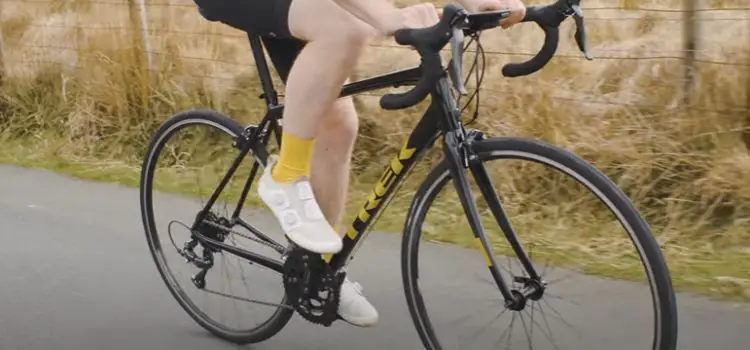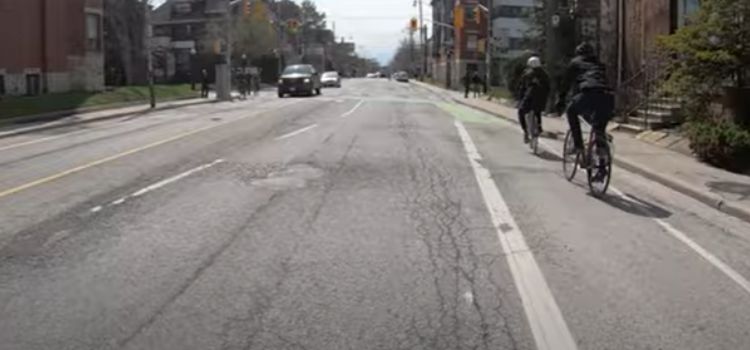Giant vs. Trek Road Bikes: Detailed Comparison!
As an Amazon Associate I earn from qualifying purchases.
When it comes to the exhilarating world of road biking, the debate between Giant and Trek is nothing short of legendary. Cycling enthusiasts find themselves standing at the crossroads, torn between the cutting-edge innovations of Trek and the affordability of Giant.
In this comprehensive guide, we embark on a journey through the nuances of Giant vs. Trek road bikes, dissecting everything from design and innovation to performance and price. So, saddle up as we delve into the heart of this cycling rivalry.

Giant and Trek: Cycling Giants
Before we pedal into the specifics, let’s take a moment to understand the behemoths we’re dealing with. Giant, the world’s largest bicycle manufacturer, goes head-to-head with Trek, a respected and popular brand dominating the American market. Both brands cater to a wide spectrum of cyclists, offering models across various categories and price points.
In the grand scheme of things, comparing Giant and Trek is akin to the age-old debate between Chevrolet and Ford. Both boast solid reputations and ardent fanbases, making the decision between the two a matter of personal preference. As we dive deeper into the comparison, subtle differences emerge, providing insights to help you make an informed choice.
Giant vs. Trek: The Product Range Face-Off
One of the pivotal aspects of choosing a road bike is the breadth of options available. In this arena, Trek takes the lead in the American market, boasting the broadest range of bicycle options. Whether you’re a novice seeking an entry-level bike or a seasoned professional in search of high-performance models, Trek has you covered.
On the other hand, Giant, while impressive in its selection, falls slightly behind Trek in terms of product range. An intriguing fact about Giant is its ability to manufacture bikes designed by competing brands. This flexibility stems from Giant’s state-of-the-art manufacturing facilities spread across the globe, showcasing their prowess in the industry.
Design Philosophy: Flash vs. Practicality
The aesthetics of road bikes often sway the decision-making process. In the case of Trek, road bike designs exude flashiness and cutting-edge aesthetics. The emphasis is on research and development, with a focus on enhancing both the look and feel of the bike when you’re in the saddle. Trek road bikes are a preferred choice for those who seek not just performance but also a visually striking ride.
Conversely, Giant’s road bike designs are more understated, leaning towards practicality and quality components over turning heads on the road. Giants merge the practical aspects of their bike designs with added performance, offering a different appeal compared to the more streamlined approach adopted by Trek.
Innovations: Trek’s Technological Symphony vs. Giant’s Engineering Marvels
Both Trek and Giant have played pivotal roles in revolutionizing bike manufacturing, bringing forth innovations that have reshaped the cycling landscape. Trek’s impressive lineup of technologies includes OCLV Carbon, Alpha Aluminum, Active Braking Pivot, RE:aktiv, Full Floater, and Trek IsoSpeed. These innovations have not only garnered acclaim but have also set a standard for reliability and performance in racing bikes.
Giant, on the other hand, introduces its own array of engineering marvels, such as Cadex, Compact Road Design, OverDrive, Comax Composite Technology, Maestro Suspension, and Dfuse Technology. Each innovation contributes to enhancing the overall biking experience, showcasing Giant’s commitment to comfort and quality.
As both brands continue to push the boundaries of design and functionality, prospective buyers might find the decision influenced by the specific technologies present in the models they’re considering.
Price Tag Showdown: Trek’s Premium vs. Giant’s Affordability
A crucial factor in the Giant vs. Trek conundrum is the price point. Trek road bikes generally come with a higher price tag compared to their Giant counterparts. The primary reason behind this price difference lies in the manufacturing locations. Trek bikes are proudly manufactured in the United States, where components are pricier. In contrast, giant bikes are produced in Taiwan, benefiting from a more cost-effective supply chain and mature manufacturing technology.
Giant’s affordability stems from its ability to keep costs down, allowing the inclusion of high-quality components without breaking the bank. The closely interwoven supply chain in Taiwan, from suppliers to OEM companies, results in shortened lead times for materials, manufacturing, and design. Giant’s commitment to in-house control from ideation to the finished product contributes to their ability to bring bikes to the market at a more competitive price without compromising on quality.
In the realm of road bikes, the general rule prevails: more expensive bikes often offer superior manufacturing and performance. While both Giant and Trek cater to a range of budgets, the price-conscious consumer might find Giant’s offerings more appealing.
Frame Material: Trek’s Indestructible OCLV Carbon vs. Giant’s Advanced Grade Composite
The frame material is the backbone of any road bike, determining its strength, weight, and overall durability. Trek, renowned for producing indestructible road bikes, relies on the robust OCLV carbon fiber for constructing its frames. Some models feature aluminum frames crafted through the hydrofoaming process, reducing weight and stiffness in critical areas for a smoother ride.
Trek’s commitment to engineering quality carbon is evident in the OCLV Carbon, which surpasses aerospace standards, ensuring durability and strength. Wind tunnel testing is utilized to optimize aerodynamics, resulting in stiff and rugged frames that excel in various riding conditions.
Giant, on the other hand, utilizes Advanced Grade Composite (Raw Carbon) for its bike frames. This material strikes a balance between lightness and durability, offering an excellent stiffness-to-weight ratio. Some Giant frames employ Modified Monocoque Construction, where the front triangle is molded and assembled as one piece without compromising ride quality, frame strength, or stiffness.
It’s essential to note Giant’s roots as an OEM, initially manufacturing frames for their bikes and even some for competitors like Trek. For riders prioritizing the sheer joy of cycling, a more affordable aluminum frame might suffice, while those aiming for competitiveness and training might lean towards the sophistication of a carbon fiber frame.
Suspension and Gears: Trek’s Mastery vs. Giant’s Technological Excellence
When it comes to suspension, Trek stands out as a master of the craft. Various Trek models feature cutting-edge suspension systems designed to enhance specific aspects of the biking experience.
- Full Floater: Allows for an exceptionally responsive and nimble suspension, providing a feeling of bottomless travel.
- IsoSpeed: A road bike suspension system that decouples the seat tube from the top tube, reducing driver fatigue.
- RE:aktiv: This suspension system adapts to the terrain with effective damping and low shaft velocity.
Giant, too, boasts top-notch suspension systems demonstrating technological excellence:
- Maestro Full Suspension: Utilized in mountain bikes, this system strategically places pivot points and linkages, creating a single floating point that minimizes suspension compression.
- Flexpoint Suspension: Offers benefits similar to a multi-link system without the added cost and need for regular maintenance.
In higher-priced models, both Trek and Giant incorporate the SRAM RED eTap AXS Groupset, with mid-range models featuring Shimano kits. Differences in gear ratios exist, with Trek favoring higher gear ratios and Giant opting for lower ratios in comparable models.
Brakes: Trek’s ABP Revolution vs. Giant’s Hydraulic Disc Prowess
Trek’s revolution in the biking industry comes in the form of their patented Active Braking Pivot (ABP) system. This innovation addresses the long-standing challenge of integrating brakes and the suspension system, resulting in smoother braking experiences. The ABP system enables the suspension to function optimally while braking, minimizing skidding, reducing chatter, and instilling driver confidence.
Both Trek and Giant road bikes employ hydraulic disc brakes, with rim brakes occasionally found on older or specific models. Hydraulic disc brakes are revered for their efficiency and durability, making them the preferred braking system for road bikes. While both brands offer a range of brakes tailored to different bike types, hydraulic disc brakes stand out as the pinnacle of braking technology.
Pro-Cycling Wins: Trek’s Triumphs on the Racing Circuit
For avid fans of competitive racing, the track record of pro-cycling wins can sway brand allegiance. Trek boasts an impressive history of victories on the pro-cycling circuit, with numerous wins across various years. This track record solidifies Trek’s reputation as a manufacturer of high-performance bikes tailored for professional racing.
Year after year, Trek’s dominance in pro-cycling competitions underscores their commitment to excellence and innovation in bike manufacturing. While Giant also enjoys victories in the racing realm, Trek’s consistent performance places them at the forefront of competitive cycling.
Giant vs. Trek Road Bikes: Performance Paradox
Performance lies at the heart of the Giant vs. Trek debate, reflecting the distinctive philosophies embraced by each brand. Trek road bikes are synonymous with heavy-duty racing, offering superior rear suspension that effortlessly tackles any terrain. The emphasis on performance makes Trek an ideal choice for riders seeking speed and precision in their cycling endeavors.
Conversely, giant road bikes cater to the average rider, prioritizing comfort and accessibility over aggressive performance. Giant’s road bikes offer a more relaxed and enjoyable riding experience, earning them the moniker of “souped-up” tourist bikes. While Giant may not match Trek in sheer racing prowess, they excel at delivering a smooth and comfortable ride suitable for a wide range of cyclists.
E-bikes: Trek’s Versatility vs. Giant’s Varied Offerings
In the realm of electric bikes (e-bikes), both Trek and Giant showcase their versatility and innovation. Trek’s extensive lineup of e-bike models covers a wide spectrum of categories, catering to diverse consumer preferences and riding styles. From urban commuters to off-road adventurers, Trek’s e-bikes offer a solution for every rider.
Giant’s e-bike range mirrors this diversity, providing an array of options tailored to different riding needs. Recent advancements in battery technology have led to the introduction of powerful e-bike models with enhanced performance and range. As e-bikes continue to gain popularity, both Trek and Giant remain at the forefront of innovation, pushing the boundaries of electric cycling.
Gravel Bikes: Trek’s Checkpoint vs. Giant’s Revolt
Gravel bikes represent the epitome of versatility, capable of traversing gravel paths and tarmac with ease. Trek’s Checkpoint SLR 9 eTap and Giant’s Revolt Advanced Pro embody the spirit of adventure, offering riders a seamless blend of performance and durability.
Trek’s Checkpoint series has garnered acclaim for its cutting-edge design and unrivaled performance on diverse terrain. Meanwhile, Giant’s Revolt series presents a more budget-friendly option without compromising on quality or performance.
Mountain Bikes: Trek’s Legacy vs. Giant’s Ingenuity
As leaders in the mountain biking industry, Trek and Giant offer a myriad of options for riders seeking off-road adventures. Trek’s legacy in mountain biking is exemplified by its commitment to superior frame design and innovative suspension systems. From cross-country trails to rugged downhill descents, Trek mountain bikes deliver unrivaled performance and reliability.
Giant’s mountain bikes showcase a blend of ingenuity and craftsmanship, catering to riders of all skill levels. With top-quality components and cutting-edge frame technology, Giant mountain bikes offer an exhilarating riding experience across varied terrain.
Warranty and Customer Service: Trek’s Assurance vs. Giant’s Commitment
A robust warranty and exceptional customer service are hallmarks of reputable bike manufacturers like Trek and Giant. Trek offers lifetime warranties on frames and forks, coupled with a comprehensive two-year warranty on parts, accessories, and apparel. Giant’s warranty covers one year for original components and paint finish, ensuring peace of mind for riders.
Both Trek and Giant prioritize customer satisfaction, offering dedicated support channels and service centers. Trek’s extensive retail network provides faster service delivery, enhancing the overall customer experience. Regardless of brand allegiance, registering your bike for warranty coverage is essential to safeguarding your investment.
Conclusion: Riding into the Sunset
As we reach the end of our epic journey through the world of Giant vs. Trek road bikes, one thing becomes abundantly clear: the choice is yours to make. Whether you’re drawn to Trek’s premium performance or enticed by Giant’s affordability and comfort, the decision ultimately reflects your unique riding preferences and aspirations.
In the grand tapestry of cycling, Giant and Trek stand as titans, each offering a distinct blend of innovation, craftsmanship, and performance. As you embark on your cycling odyssey, remember that the true essence of biking lies not in the brand but in the exhilarating sensation of the open road beneath your wheels.
So, heed the call of adventure, embrace the wind in your face, and pedal forth with the spirit of exploration. Whether you choose the towering heights of Trek or the steadfast reliability of Giant, may your journey be filled with joy, discovery, and endless miles of unforgettable rides.
Amazon and the Amazon logo are trademarks of Amazon.com, Inc, or its affiliates.






